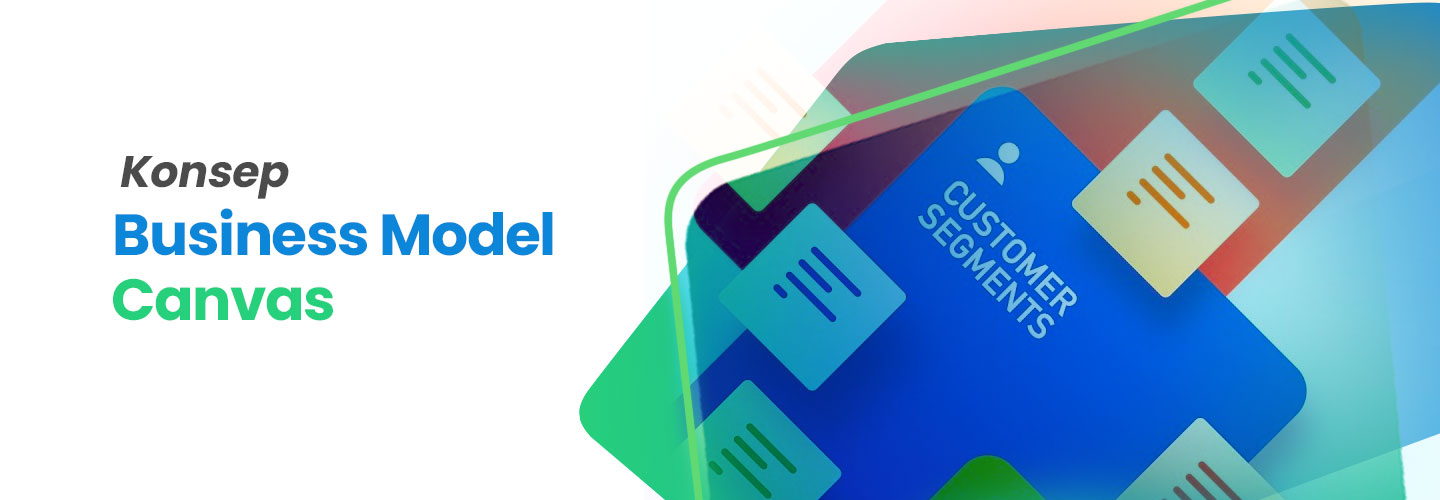Panduan Menggunakan Business Model Canvas Sebagai Fondasi Memulai Bisnis

Sebuah ide bisnis akan mudah diwujudkan ketika Anda memiliki pemahaman yang komprehensif akan ide yang dimiliki. Business Model Canvas (BMC) merupakan alat yang tepat untuk memahami dan mengembangkan berbagai ide bisnis.
BMC merupakan dokumen penting yang memuat berbagai informasi fundamental yang disajikan secara terstruktur dengan pendekatan visual. Pemahaman ide bisnis yang baik dan holistik, dapat dijadikan fondasi yang kuat untuk membangun perusahaan Anda.
Mengenal Konsep Business Model Canvas
Business Model Canvas (BMC) adalah alat yang digunakan untuk memetakan dan memvisualisasikan sebuah model bisnis dengan singkat, padat, dan jelas di dalam satu halaman saja.
Alat manajemen ini dikembangkan oleh Alexander Osterwalder, seorang pebisnis dan ahli teori bisnis yang berasal dari Swiss. Selain Osterwalder, seorang profesor manajemen sistem informasi dari Belgia bernama Yves Pigneur turut mengembangkannya.
BMC bersifat strategis karena mencakup sembilan elemen esensial mengenai sebuah model bisnis. Melalui BMC, pebisnis maupun stakeholders dapat memahami dengan jelas bagaimana sebuah bisnis beroperasi.
Keuntungan Menggunakan Business Model Canvas
BMC telah memberikan banyak manfaat untuk berbagai pebisnis dari berbagai sektor industri di berbagai belahan dunia. Berikut sejumlah keuntungan dari penggunaan BMC:
1. Fokus dengan Value Proposition
Ketika membangun sebuah bisnis, fokus pengusaha sering kali terpecah dan terdistraksi. Hal ini membuat Anda melupakan salah satu elemen esensial dalam bisnis yaitu value proposition. Value proposition merupakan manfaat produk yang Anda tawarkan kepada konsumen.
Manfaat yang ditawarkan harus menjadi keunggulan yang unik agar konsumen membeli produk Anda. Value proposition menjadi elemen utama yang dapat membantu Anda untuk tetap fokus dengan keunggulan bisnis yang akan Anda bawa.
2. Memberikan Perspektif yang Holistik
Dengan BMC, Anda dapat melihat bagaimana seluruh elemen bisnis berhubungan dan mempengaruhi satu sama lain. Perspektif ini dapat memberikan pemahaman yang menyeluruh tentang operasional bisnis Anda, baik sebagai sistem yang berdiri sendiri maupun di dalam ekosistem bisnis.
3. Membantu Komunikasi dengan Stakeholder
Bentuk BMC yang sangat visual dan sederhana membuatnya mudah dipahami oleh siapa saja. Jika sebuah bisnis telah memiliki BMC dengan informasi yang lengkap dan jelas, hal ini dapat dijadikan bahan presentasi atau pitching kepada calon investor, tim, atau mitra bisnis.
Mengenal Sembilan Elemen dan Cara Membuat Business Model Canvas
Membuat BMC sangat sederhana, Anda tinggal mengisi blok-blok yang terdiri dari sembilan elemen kunci sebuah bisnis. Berikut sembilan elemen bisnis yang perlu Anda isi dalam BMC.
1. Value Proposition (Nilai Manfaat Produk atau Layanan)
Nilai manfaat produk merupakan elemen fundamental dalam suatu ide bisnis. Pada umumnya, nilai ini berkaitan dengan alasan-alasan kuat dan unik agar konsumen menggunakan produk atau layanan yang Anda tawarkan.
Tuliskan kekuatan produk atau layanan Anda dalam memenuhi kebutuhan konsumen. Selain itu, pertegas argumen bahwa bisnis Anda menawarkan solusi dari permasalahan atau pain points yang dimiliki konsumen.
2. Customer Segments (Segmentasi Konsumen)
Segmentasi konsumen merupakan langkah untuk mengelompokkan berbagai jenis konsumen berdasarkan beberapa indikator seperti umur, jenis kelamin, hobi, daya beli, pola konsumsi, dan sejenisnya. Aspek ini membantu mengidentifikasi potensi bisnis terhadap berbagai segmentasi konsumen serta mengukur ukuran market yang disasar.
3. Channels (Jalur Distribusi)
Menurut Osterwalder dan Pigneur, ada lima fase penting dalam menentukan distribusi yang efektif untuk sebuah bisnis. Fase tersebut adalah awareness (kesadaran), evaluation (evaluasi), purchase (pembelian), delivery (pengiriman), dan after sales (layanan purna jual).
Sebuah produk atau layanan harus dapat menjangkau para konsumen. Pilihlah jalur distribusi yang dapat menjangkau target konsumen Anda. Di era digital, jalur distribusi semakin beragam, dari marketplace, e-commerce, hingga media sosial.
4. Customer Relationship (Hubungan Konsumen)
Elemen ini menentukan cara sebuah bisnis berinteraksi dan menjaga hubungan baik dengan konsumennya. Anda dapat membuat user journey map untuk mengetahui cara paling efektif untuk menjalin relasi dengan konsumen melalui media sosial, acara offline, atau menyewa jasa pihak ketiga.
5. Revenue Streams (Sumber Pendapatan)
Sumber pendapatan diperoleh dari cara bisnis atau perusahaan mengubah nilai manfaat produk atau layanan menjadi keuntungan finansial. Perhatikan pengaturan harga yang tepat agar bisnis Anda mendapatkan keuntungan yang optimal. Terdapat berbagai model pendapatan yang dapat dilakukan di antaranya harga satuan per produk atau biaya berlangganan.
6. Key Resources (Sumber Daya Krusial)
Buatlah daftar aset serta sumber daya krusial yang dibutuhkan agar bisnis Anda dapat beroperasi dengan lancar. Sumber daya yang dibutuhkan juga harus mampu mewujudkan value yang bermanfaat bagi bisnis baik dalam bentuk fisik, intelektual (paten), SDM, dan keuangan.
7. Key Activities (Aktivitas Kunci)
Rangkum jenis kegiatan yang mendukung bisnis Anda untuk dapat memberikan nilai manfaat yang direncanakan. Baik hal-hal yang bersifat teknis seperti desain atau strategis seperti jasa consulting.
8. Key Partnership (Kerjasama Kunci)
Buat daftar mitra potensial yang dapat diajak bekerjasama dalam mendukung kesuksesan bisnis Anda. Rangkum pula keuntungan yang didapatkan dari kerjasama tersebut.
9. Cost Structure (Struktur Biaya)
Hitung dan identifikasi biaya-biaya yang harus Anda disiapkan agar bisnis Anda beroperasi. Baik dari proses produksi hingga produk atau jasa dibeli oleh konsumen dan menghasilkan keuntungan finansial.
Itulah beberapa panduan untuk menggunakan business model canvas (BMC) sebagai pondasi untuk membangun bisnis. Perumusan business model canvas juga harus didasari dengan adanya fungsi perencanaan yang baik.
Hal ini dapat dilatih melalui program Strategic Business Analysis karena para manajer dan direksi dapat melakukan fungsi pimpinan untuk mencapai target bisnis melalui kerja sama tim dengan mengimplementasi strategi bisnis yang tepat.